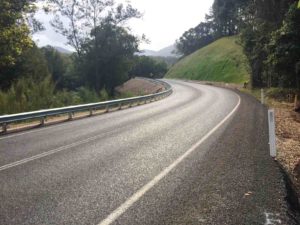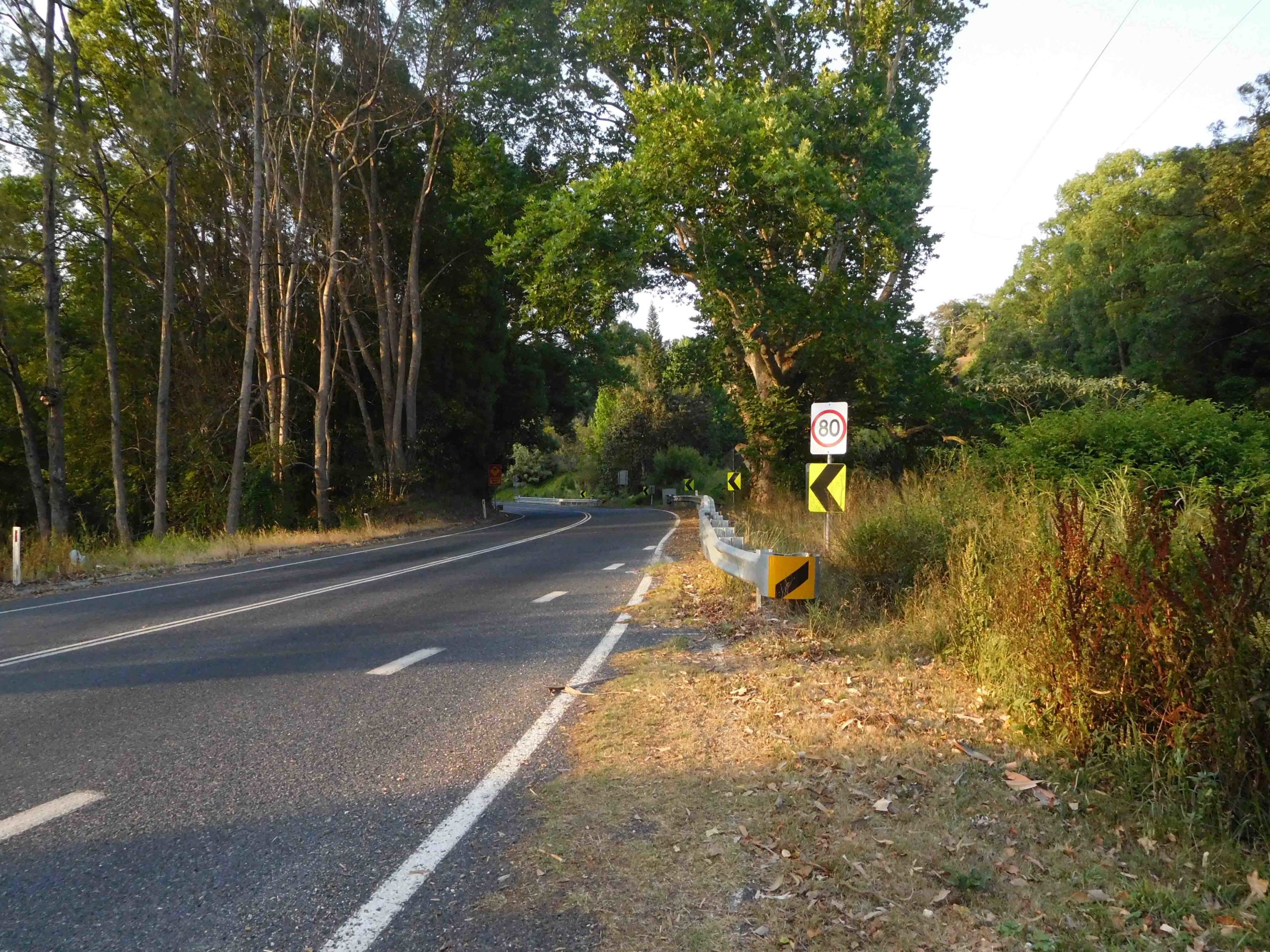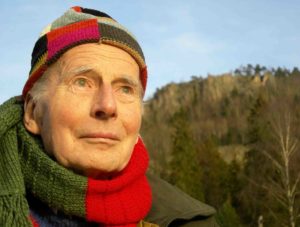Looking back over four years, I can proudly celebrate the depth and breadth of our activism in Karl’s name:
- analysis of the road conditions and numerous communications to the Tweed Shire Council, the press and the State Coroner;
- a detailed request for a coronial inquest (investigated but ultimately refused);
- our World Day of Remembrance for Road Traffic Victims media conference, action and video in September 2016;
- my Victim Impact Statement in 2016;
- Bless this Road in September 2016;
- networking with victims and survivors; and
- authoring three academic articles about the effects of my experience.
With Steph Vajda, I am working on a film about my activism, with the working title, Nothing but Dreams.
I am also responsible for three hard-hitting articles in the local press about safety problems with Kyogle Road.
I did a televised interview in December 2016. That television program about the national road toll was aired in South Australia and Perth to a robust response.
Most heartwarming of all, we held our dramatic and soulful healing and celebratory event, Bless this Road, in the company of seventy other grieving people and our supporters (see www.blessthisroad.blog).
The road has been repaired
The (mostly) good news is that our activism has succeeded. The stretch of Kyogle Road where Karl and Cecilia, and Matilda Bevelander (and three other people) died has been repaired with Federal Black Spot funding of $AUD1.05 million. It opened in September 2018, days before our commemorative event.
Sadly, our expert road safety specialist advice reveals that the Tweed Shire Council did a pretty average road repair job on this stretch of the Kyogle, consistent with the previous quality of their roadworks. The repaired road is still unsafe, its safety rating increasing from one star (the lowest possible safety rating) to only two stars. The road speed was raised in late 2019 to 80 kilometers per hour. Lowering the speed limit (to 60 or 70 k.p.h.) would probably mean that the repaired section could now have a three-star rating. The Council raised the speed limit in October 2019 from 60 km. per hour to 80 km. per hour, outraging some local residents and the family and friends of some young victims of the 2015 crash.
The removal of earth from one side of the original road has significantly increased the steepness of the road (in, effect, a hill), increase the length of the drop into the Tweed River from the Road, and created a new, dangerous blind corner.

And it appears that part of the guardrail has been installed on the wrong (not along the river side) of the road.

We are still discussing this potential defect with our specialist road safety advisors.
Road safety activism as a survivor mission: would we do this again?
Speaking for myself, Lori and Kev, I’d say definitely. Collaborative activism dramatically reduces the isolation of the grieving person. We have had many victories (and finally, the repaired road and Bless this Road). I am confident that my co-conspirators would agree that the most significant achievement was getting Wendy out the door.
Activism gives loving friends something valuable and visible to do
Importantly, activism also gives loving friends something useful and visible to do. Our “survivor mission” work called us to draw on our most mature and adaptive coping skills, a sophisticated level of teamwork, applied research, networking, and qualities of patience, anticipation, and altruism. It also summoned up our sense of humor (which we were desperately missing after Karl’s death). We would find ourselves howling with laughter at the apparent futility of our task and marveling at the idiocy of the people we were encountering.
Lori, Kev and I are out to make amends, to raise community awareness, and to protect future road users. The Council must fix the road. They must mend their badly broken road safety systems. We must hold people accountable. Much more than Wendy’s mental health is at stake. Like young Karl in the Bavarian orphanage, we are holding the perpetrators responsible for their actions — for the health and safety of our broader society. We are trying to clean up a huge mess. We are after justice. And we achieved it.
A caveat: activism is not for everybody
Just as I did not immediately become a road safety activist, so not all grieving people will want to pursue the path of advocacy or activism. I’d be the first to acknowledge that my previous experience as an activist and community organizer helped me to re-engage. And I had the perfect friends for the job. A few years ago, Kev, Karl, and I worked for one intensive year on a fast-paced and highly successful volunteer social action campaign in the Queensland mining town of Blackwater. We trusted each other and had great results.
Lori, with a PhD in road safety, has extensive and in-depth senior-level professional, management, and research experience in road safety. She has friends in high places. And she has a great sense of fun. We laughingly christened ourselves Thelma and Louise (but plan to avoid their tragic end). Long before the crash, we discovered that we were soul sisters. Our activism was a logical next step in our deepening and rewarding friendship.
Conversations about activism with Karl
In his life, Karl’s activism was primarily about justice for disempowered people. (Actually, he preferred animals to people, so that sentence should probably read for all beings.)
“Gone to God,” Karl pronounces softly over the furry grey micro bat that has been trapped in our shed, lying on its back, black eyes fixed on the ceiling. He wraps the tiny creature gently in a tea towel, carefully carries it outside, and tenderly buries it in the garden, whispering a prayer, inaudible to me.
As our celestial guide to road safety activism, Karl is highly proactive. He adores Kev and is also very positive about Lori, though he knows her less well: “Lori is great and a great friend to you,” he tells me after his death.
In late June 2016, anticipating my life beyond the confines of grieving, Karl is eager for me to heal and return to my life: “You now need to seize control of the whole situation, while still keeping an eye on your energy and resources.”
A week later, I could sense him smiling, even celebrating (maybe with a celestial glass of champagne), as I record his message:
That was you I heard singing tonight, wasn’t it?
That’s my old Wadie.
We want that Wadie back.

The frontier is long
As soon as Karl saw signs of his “old Wadie” re-emerging, there was no stopping him. Full of hope for my future, he invokes our favorite environmental philosopher, the father of Deep Ecology.
Karl says:
I know that you’ve suffered much. All I can say is that the future is bright. And what was that saying by Arne Naess, ‘the frontier is long’?
At the time, I do not regard Karl’s reference to Arne Naess as particularly significant.

We have both studied environmental philosophy and consider ourselves to be Deep Ecologists. Now I see his reference to Naess as a significant and prescient foreshadowing. Karl sees more deeply into my soul than I can. I am beginning to return to activism. I am starting to heal, to leave a life focussed primarily on self-care. I am re-entering my community as an activist. I am seeking a new frontier.
Within days, Karl is reinforcing his earlier views:
I can see lots of breakthroughs happening. You are finally learning patience.
A TASTE OF MY REAL LIFE COMING BACK
Immediately before our November 2016 World Day of Remembrance for Road Traffic Victims media event (when I hung the huge poster on a roadside tree), Karl exclaims:
I love the road safety action you are proposing. Isn’t Lori a treat! Your new sister. She’s so like you. I admire what you are doing. It’s brave. My brave Wadie. You are on the cusp, dear Wadie. You have had a taste of your real life coming back.
